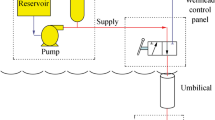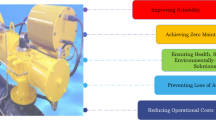Abstract
Subsea development is moving constantly toward simplification, digitalization, and cost-out strategies because the exploration and production of hydrocarbons are moving toward deeper and remote sea water areas. Usage of all-electric subsea technology instead of hydraulic technology is growing and will be the future of subsea systems due to the former’s environmental and functional advantages and reduced costs. The benefits of all-electric subsea systems are health, safety, and environment (HSE) and improved reliability, flexibility, and functionality compared with traditional hydraulic-electrical systems. Existing electrohydraulic technology for a typical subsea system, hydraulic and electric actuators, and subsea manifold valves including valve types and selection philosophy have been reviewed in this paper. Some major worldwide oil companies such as Equinor and Schlumberger have successful experiences with subsea electric actuators. Considering the benefits of all-electric technology especially in terms of cost and HSE, as well as successful experiences of two major oil companies, further research in this area is warranted. One of the gaps in existing reviewed literature is the effect of using all-electric actuators for manifold valves. Thus, three main questions related to electric actuator selection, requirement of safety integrity level (SIL), and effect of using electric actuators on manifold valve selection have been addressed and answered. Forty hydraulic actuated manifold valves from nine past subsea projects in different parts of the world, mainly Africa and Australia, have been selected for the analysis of all-electric actuators. Results show that 93% of the valves require spring-return electric actuators, whereas 7% can be operated with conventional electric actuators without any spring. The manifold valves do not require SIL certification because they are not connected to an emergency shut down system. Introducing the electric actuators to the manifold valve will not change the valve selection philosophy.












Similar content being viewed by others
References
Abicht D, Halvorsen GR (2017) Subsea all-electric. Offshore Technology Conference, Houston
API (2011) Design and operation of subsea production systems, subsea wellhead and tree equipment. 2nd edition, American petroleum institute (API) 17D, Washington, DC
API (2016) Valve selection guide. 2nd edition, American petroleum institute (API) 615, Washington, DC
API (2017) Specification for subsea pipeline valves. 3rd edition, American petroleum institute (API) 6DSS, Washington, DC
API (2018) Specification for wellhead and tree equipment. 21st edition, American petroleum institute (API) 6A, Washington, DC
Bai Y, Bai Q (2012) Subsea engineering handbook, 1st edn. Elsevier, Atlanta
ESI Technologies Group (2019) SIL certificate ball valves and actuators: a brief review of SIL. Available from: https://esitechgroup.com/blog/sil-certified-ball-valves/. Accessed 10th of Jul 2019
Gonzalez C (2015) What is the difference between pneumatic, hydraulic and electrical actuators? Machine Design. Available from: https://www.machinedesign.com/linear-motion/what-s-difference-between-pneumatic-hydraulic-and-electrical-actuators. Accessed 10th of Jul 2019
International Electrotechnical Commission (2010) Functional safety of electronic / programmable electronic safety-related systems, Part I: General requirements, 2nd edition, IEC 61508, Genova
ISO (2009) Petroleum and natural gas industries-pipeline transportation systems- subsea pipeline valves. 2nd edition, International Organization for Standardization (ISO) 14723, Geneva
ISO (2010a) Petroleum and natural gas industries-design and operation of subsea protection systems. Part 4: Subsea wellhead and tree equipment. 2nd edition, International Organization for Standardization (ISO) 13628–4, Geneva
ISO (2010b) Petroleum and natural gas industries-drilling and production-wellhead and christmas equipment. 4th edition, International Organization for Standardization (ISO) 10423, Geneva
Joyee W (2015) Subsea electrical actuators and latches for them. Aker Subsea, Aberdeen, UK
Larsen EW, Massie D, Eriksson KG (2016) Subsea all-electric technology: enabling next generation field developments. Offshore technology conference, Houston OTC-27243-MS
Norwegian Oil and Gas Association (2018) Application of IEC 61508 & 61511 in the Norwegian petroleum industry (recommended SIL requirements). Revision 3
One Subsea, A Schlumberger Company (2019) All-electrical technologies. Retrieved from: https://www.onesubsea.slb.com/control-systems/all-electric. Accessed 10th of Jul 2019
Orth A, Hendrix G (2018) An electro-mechanical actuator with hydrostatic drive for subsea trees to reduce CAPEX and OPEX with higher reliability and safety levels. Offshore Technology Conference, OTC-28828-MS.
Pishock D (2016) Choosing between a double acting and spring return actuator. Available from: https://valveman.com/blog/double-acting-vs-spring-return-actuators/. Accessed 10th of Jul 2019
Praveen J, Pathan M, Ansari K (2018) Hyperbaric pressure testing of a subsea valve to validate deep water condition. International Journal of Mechanical and Production Engineering Research and Development 8(2):1011–1022
Schlumberger Company (2018). LEDEEN hydraulic actuators and controls. Available from: https://www.products.slb.com/valves/brands/ledeen/ledeen-hydraulic-actuators. Accessed 10th of Jul 2019
Society for Underwater Technology (2008) Subsea production control. SUT, Subsea awareness course
Sotoodeh K (2019) Safety integrity level in valves. J Fail Anal Prev 18(3):832–837. https://doi.org/10.1007/s11668-019-00666-2
Theobald M (2005) Benefits of all-electric subsea production control systems. British Petroleum, Offshore Technology Conference, Houston
Wikipedia (2019) Safety integrity level. Available from: https://en.wikipedia.org/wiki/Safety_integrity_level. Accessed 10th of Jul 2019
Acknowledgments
I would like to express my gratitude to my partner, Ms. Tamara Zhunussova, for her great support.
Author information
Authors and Affiliations
Corresponding author
Additional information
Article Highlights
• All electrical subsea system and actuation reduces the cost and provide higher environmentally solution compared to hydraulic and electrical subsea system.
• There is no safety integrity level (SIL) is associated with manifold valves.
• Changing the actuators from hydraulic to electrical in subsea manifolds does not bring any safety integrity level requirements for the actuated valves.
• Electrical actuators also called motor could be supplied with spring for achieving fail safe close mode of operation.
Rights and permissions
About this article
Cite this article
Sotoodeh, K. All-Electric Subsea Control Systems and the Effects on Subsea Manifold Valves. J. Marine. Sci. Appl. 19, 465–472 (2020). https://doi.org/10.1007/s11804-020-00155-1
Received:
Accepted:
Published:
Issue Date:
DOI: https://doi.org/10.1007/s11804-020-00155-1




